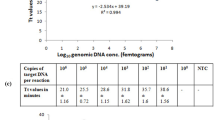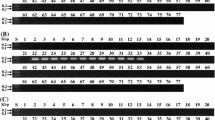Abstract
A real-time polymerase chain reaction (PCR) assay was developed for rapid identification of Bacillus anthracis in environmental samples. These samples often harbor Bacillus cereus bacteria closely related to B. anthracis, which may hinder its specific identification by resulting in false positive signals. The assay consists of two duplex real-time PCR: the first PCR allows amplification of a sequence specific of the B. cereus group (B. anthracis, B. cereus, Bacillus thuringiensis, Bacillus weihenstephanensis, Bacillus pseudomycoides, and Bacillus mycoides) within the phosphoenolpyruvate/sugar phosphotransferase system I gene and a B. anthracis specific single nucleotide polymorphism within the adenylosuccinate synthetase gene. The second real-time PCR assay targets the lethal factor gene from virulence plasmid pXO1 and the capsule synthesis gene from virulence plasmid pXO2. Specificity of the assay is enhanced by the use of minor groove binding probes and/or locked nucleic acids probes. The assay was validated on 304 bacterial strains including 37 B. anthracis, 67 B. cereus group, 54 strains of non-cereus group Bacillus, and 146 Gram-positive and Gram-negative bacteria strains. The assay was performed on various environmental samples spiked with B. anthracis or B. cereus spores. The assay allowed an accurate identification of B. anthracis in environmental samples. This study provides a rapid and reliable method for improving rapid identification of B. anthracis in field operational conditions.



Similar content being viewed by others
References
Altschul SF, Madden TL, Schaffer AA, Zhang J, Zhang Z, Miller W, Lipman DJ (1997) Gapped BLAST and PSI-BLAST: a new generation of protein database search programs. Nucleic Acids Res 25:3389–3402
Antwerpen MH, Zimmermann P, Bewley K, Frangoulidis D, Meyer H (2008) Real-time PCR system targeting a chromosomal marker specific for Bacillus anthracis. Mol Cell Probes 22:313–315
Beyer W, Glockner P, Otto J, Bohm R (1995) A nested PCR method for the detection of Bacillus anthracis in environmental samples collected from former tannery sites. Microbiol Res 150:179–186
Cheun HI, Makino SI, Watarai M, Erdenebaatar J, Kawamoto K, Uchida I (2003) Rapid and effective detection of anthrax spores in soil by PCR. J Appl Microbiol 95:728–733
Dixon TC, Meselson M, Guillemin J, Hanna PC (1999) Anthrax. N Engl J Med 341:815–826
Easterday WR, Van Ert MN, Zanecki S, Keim P (2005) Specific detection of Bacillus anthracis using a TaqMan mismatch amplification mutation assay. Biotechniques 38:731–735
Ellerbrok H, Nattermann H, Ozel M, Beutin L, Appel B, Pauli G (2002) Rapid and sensitive identification of pathogenic and apathogenic Bacillus anthracis by real-time PCR. FEMS Microbiol Lett 214:51–59
Gonzy-Tréboul G, Steinmetz M (1987) Phosphoenolpyruvate:sugar phosphotransferase system of Bacillus subtilis: cloning of the region containing the ptsH and ptsI genes and evidence for a crr-like gene. J Bacteriol 169:2287–2290
Hadjinicolaou AV, Demetriou VL, Hezka J, Beyer W, Hadfield TL, Kostrikis LG (2009) Molecular beacons and multi-allelic real-time PCR for detection of and discrimination between virulent Bacillus anthracis and other Bacillus isolates. J Microbiol Methods 78:45–53
Harling R, Twisselmann B, Asgari-Jirhandeh N, Morgan D, Lightfoot N, Reacher M, Nicoll A, Deliberate Release Teams (2001) Deliberate releases of biological agents: initial lessons for Europe from events in the United States. Euro Surveill 6:166–167
Helgason E, Okstad OA, Caugant DA, Johansen HA, Fouet A, Mock M, Hegna I, Kolsto AB (2000) Bacillus anthracis, Bacillus cereus, and Bacillus thuringiensis—one species on the basis of genetic evidence. Appl Environ Microbiol 66:2627–2630
Hoffmaster AR, Meyer RF, Bowen MD, Marston CK, Weyant RS, Thurman K, Messenger SL, Minor EE, Winchell JM, Rassmussen MV, Newton BR, Parker JT, Morrill WE, McKinney N, Barnett GA, Sejvar JJ, Jernigan JA, Perkins BA, Popovic T (2002) Evaluation and validation of a real-time polymerase chain reaction assay for rapid identification of Bacillus anthracis. Emerg Infect Dis 8:1178–1182
Hoffmaster AR, Ravel J, Rasko DA, Chapman GD, Chute MD, Marston CK, De BK, Sacchi CT, Fitzgerald C, Mayer LW, Maiden MC, Priest FG, Barker M, Jiang L, Cer RZ, Rilstone J, Peterson SN, Weyant RS, Galloway DR, Read TD, Popovic T, Fraser CM (2004) Identification of anthrax toxin genes in a Bacillus cereus associated with an illness resembling inhalation anthrax. Proc Natl Acad Sci USA 101:8449–8454
Hoffmaster KK Hill, Gee JE, Marston CK, De BK, Popovic T, Sue D, Wilkins PP, Avashia SB, Drumgoole R, Helma CH, Ticknor LO, Okinaka RT, Jackson PJ (2006) Characterization of Bacillus cereus isolates associated with fatal pneumonias: strains are closely related to Bacillus anthracis and harbor B. anthracis virulence genes. J Clin Microbiol 44:3352–3360
Hu X, Swiecicka I, Timmery S, Mahillon J (2009) Sympatric soil communities of Bacillus cereus and Bacillus thuringiensis: population structure and potential plasmid dynamics of pXO1- and pXO2-like elements. FEMS Microbiol Ecol 70:344–355
Jernigan DB, Raghunathan PL, Bell BP, Brechner R, Bresnitz EA, Butler JC, Cetron M, Cohen M, Doyle T, Fischer M, Greene C, Griffith KS, Guarner J, Hadler JL, Hayslett JA, Meyer R, Petersen LR, Phillips M, Pinner R, Popovic T, Quinn CP, Reefhuis J, Reissman D, Rosenstein N, Schuchat A, Shieh WJ, Siegal L, Swerdlow DL, Tenover FC, Traeger M, Ward JW, Weisfuse I, Wiersma S, Yeskey K, Zaki S, Ashford DA, Perkins BA, Ostroff S, Hughes J, Fleming D, Koplan JP, Gerberding JL, National Anthrax Epidemiologic Investigation Team (2002) Investigation of bioterrorism-related anthrax, United States, 2001: epidemiologic findings. Emerg Infect Dis 8:1019–1028
Kim K, Seo J, Wheeler K, Park C, Kim D, Park S, Kim W, Chung SI, Leighton T (2005) Rapid genotypic detection of Bacillus anthracis and the Bacillus cereus group by multiplex real-time PCR melting curve analysis. FEMS Immunol Med Microbiol 43:301–310
Klee SR, Nattermann H, Becker S, Urban-Schriefer M, Franz T, Jacob D, Appel B (2006) Evaluation of different methods to discriminate Bacillus anthracis from other bacteria of the Bacillus cereus group. J Appl Microbiol 100:673–681
Kumar R, Singh SK, Koshkin AA, RAjwanshi VK, Meldgaard M, Wengel J (1998) The first analogues of LNA (locked nucleic acids): phosphorothioate-LNA and 2′thio-LNA. Bioorg Med Chem Lett 8:2219–2222
Kutyavin IV, Afonina IA, Mills A, Gorn VV, Lukhtanov EA, Belousov ES, Singer MJ, Walburger DK, Lokhov SG, Gall AA, Dempcy R, Reed MW, Meyer RB, Hedgpeth J (2000) 3′-minor groove binder-DNA probes increase sequence specificity at PCR extension temperatures. Nucleic Acids Res 28:655–661
Leask A, Delpech V, McAnulty J (2003) Anthrax and other suspect powders: initial responses to an outbreak of hoaxes and scares. N S W Public Health Bull 14:218–221
Lecouvet F, Irenge L, Vandercam B, Nzeusseu A, Hamels S, Gala JL (2004) The etiologic diagnosis of infectious discitis is improved by amplification-based DNA analysis. Arthritis Rheum 50:2985–2994
Marston CK, Gee JE, Popovic T, Hoffmaster AR (2006) Molecular approaches to identify and differentiate Bacillus anthracis from phenotypically similar Bacillus species isolates. BMC Microbiol 6:22
Mehrotra S, Balaram H (2007) Methanocaldococcus jannaschii adenylosuccinate synthetase: studies on temperature dependence of catalytic activity and structural stability. Biochemistry 46:12821–12832
Mouritzen P, Nielsen AT, Pfundheller HM, Choleva Y, Kongsbak L, Moller S (2003) Single nucleotide polymorphism genotyping using locked nucleic acid (LNA). Expert Rev Mol Diagn 3:27–38
Olsen JS, Skogan G, Fykse EM, Rawlinson EL, Tomaso H, Granum PE, Blatny JM (2007) Genetic distribution of 295 Bacillus cereus group members based on adk-screening in combination with MLST (multilocus sequence typing) used for validating a primer targeting a chromosomal locus in B. anthracis. J Microbiol Methods 71:265–274
Pannucci J, Okinaka RT, Sabin R, Kuske CR (2002) Bacillus anthracis pXO1 plasmid sequence conservation among closely related bacterial species. J Bacteriol 184:134–141
Park SH, Kim HJ, Kim JH, Kim TW, Kim HY (2007) Simultaneous detection and identification of Bacillus cereus group bacteria using multiplex PCR. J Microbiol Biotechnol 17:1177–1182
Patra G, Sylvestre P, Ramisse V, Thérasse J, Guesdon JL (1996) Isolation of a specific chromosomic DNA sequence of Bacillus anthracis and its possible use in diagnosis. FEMS Immunol Med Microbiol 15:223–231
Qi Y, Patra G, Liang X, Williams LE, Rose S, Redkar RJ, DelVecchio VG (2001) Utilization of the rpoB gene as a specific chromosomal marker for real-time PCR detection of Bacillus anthracis. Appl Environ Microbiol 67:3720–3727
Ramisse V, Patra G, Garrigue H, Guesdon JL, Mock M (1996) Identification and characterization of Bacillus anthracis by multiplex PCR analysis of sequences on plasmids pXO1 and pXO2 and chromosomal DNA. FEMS Microbiol Lett 145:9–16
Ryu C, Lee K, Yoo C, Seong WK, Oh HB (2003) Sensitive and rapid quantitative detection of anthrax spores isolated from soil samples by real-time PCR. Microbiol Immunol 47:693–699
Skottman T, Piiparinen H, Hyytiäinen H, Myllys V, Skurnik M, Nikkari S (2007) Simultaneous real-time PCR detection of Bacillus anthracis, Francisella tularensis and Yersinia pestis. Eur J Clin Microbiol Infect Dis 26:207–211
Thompson JD, Higgins DG, Gibson TJ, Clustal W (1994) Improving the sensitivity of progressive multiple sequence alignment through sequence weighting, position-specific gap penalties and weight matrix choice. Nucleic Acids Res 22:4673–4680
Valjevac S, Hilaire V, Lisanti O, Ramisse F, Hernandez E, Cavallo JD, Pourcel C, Vergnaud G (2005) Comparison of minisatellite polymorphisms in the Bacillus cereus complex: a simple assay for large-scale screening and identification of strains most closely related to Bacillus anthracis. Appl Environ Microbiol 71:6613–6623
Van Ert MN, Easterday WR, Simonson TS, U’Ren JM, Pearson T, Kenefic LJ, Busch JD, Huynh LY, Dukerich M, Trim CB, Beaudry J, Welty-Bernard A, Read T, Fraser CM, Ravel J, Keim P (2007) Strain-specific single-nucleotide polymorphism assays for the Bacillus anthracis Ames strain. J Clin Microbiol 45:47–53
Wong ML, Medrano JF (2005) Real-time PCR for mRNA quantification. Biotechniques 39:1–11
Zilinskas RA (1997) Iraq’s biological warfare program: the past as future? JAMA 278:418–424
Acknowledgments
This project was funded by the Department Management of Scientific and Technological Research of Defence (IRSD-RSTD, Royal High Institute for Defence) supporting research and development (grants MED-03 and MED-08), by the Walloon Region (grant 616313). We thank Yann Deccache (IRSD-RSTD), Elodie Carlier (IRSD-RSTD), Cathy Delcorps (IRSD-RSTD), and Michèle Bouyer (IRSD-RSTD) for their outstanding contribution to this work. We also thank Dr Angelo Madonna (Dugway Army Proving Ground, Utah, USA) for preparation of environmental samples containing killed Bacillus anthracis spores. Contributions of partner (3), (4), (6), and (7) to this work have been provided within the framework of the project EMS 4/EDA Database for Biological Agents. Contribution of partner (5) to this work has been provided in the framework of COSTB28.
Conflict of interest
None
Author information
Authors and Affiliations
Corresponding author
Additional information
Léonid M. Irenge and Jean-François Durant contributed equally to this work.
Electronic supplementary material
Below is the link to the electronic supplementary material.
ESM Table 1
Microorganisms other than Bacillus used in this study (DOC 242 kb)
Fig. S4
Figures showing the real-time amplification curves obtained with the references DNA and with environmental samples from the SIBCRA exercises. a and b Amplification curves with LNA-BA1 probe (a) and LNA-BC2 probe (b) with serial dilutions of B. anthracis CEB 9434 DNA (from 500 pg to 50 fg). c Six amplification curves with LNA-BA1 probe of 13 of DNA extract from 13 environmental samples from the SIBCRA; d 13 amplification curves with LNA-BC2 probe of 13 DNA extracts from the same environmental samples. These amplification curves show the presence of six B. anthracis and of seven B. cereus group strains (non-B. anthracis) in these samples (DOC 3,239 kb)
Fig. S5
Alignment of purA gene sequences from 70 bacterial strains (DOC 411 kb)
Fig. S6
Alignment of ptsI gene sequences from 79 bacterial strains (DOC 396 kb)
Rights and permissions
About this article
Cite this article
Irenge, L.M., Durant, JF., Tomaso, H. et al. Development and validation of a real-time quantitative PCR assay for rapid identification of Bacillus anthracis in environmental samples. Appl Microbiol Biotechnol 88, 1179–1192 (2010). https://doi.org/10.1007/s00253-010-2848-0
Received:
Revised:
Accepted:
Published:
Issue Date:
DOI: https://doi.org/10.1007/s00253-010-2848-0




